Introduction
Online sales method is significantly becoming a fast-growing business (Barnes and Vidgen, 2001) and being more than just a source of entertainment, information, and news. It is an also important business tool for many business companies. Those companies use the internet in their daily business activities, such as LANs for intranet, extranet, and the internet to work jointly with their customers, partners, and suppliers. In addition, the internet is also a part of the centre nervous over the system of the world economics that at the same time, it equally important provides a dynamic platform for communication and business process transaction. It facilitates companies to view products by online-internet, to make an order, and to purchase goods and service, which is faster and more accessible (Hathairath, 2009).
Electronic commerce (EC), which refers to the buying and selling of products or services over electronic systems such as the Internet and other computer networks, has taken place a big portion of business forms in many countries, such as the internet economy in UK is likely to grow by 10% from 2010 to 2015. Among emerging economies, China’s ecommerce presence continues to expand. With 384 million internet users, China’s online shopping sales rose to $36.6 billion in 2009 and one of the reasons behind the huge growth has been the improved trust level for shoppers. E-Commerce has become an important tool for businesses worldwide not only to sell to customers but also to engage them (Eisingerich and Kretschmer, 2008).
Among the most popular application of e-commerce is the online auction and shopping website (McAfee and McMillan, 1987). Online auctions represent an increasingly important business sector. These kind of auctions have become widespread, and the economic value of transactions has become significant and is increasing. They are increasing in diversify of offering and represent a huge growth opportunity for marketers (Halstead and Bechere, 2003). An online auction is a new type of exchange mechanism and dealing method of products or services for which the conventional marketing channel (Turban, 1997). It has also special characteristics, i.e. prices in online auction are unpredictable, sellers, and buyers are strange each other, and difficult to make a comparison because products and items on offering may be unique or obsolete (Massad and Tucker, 2000). On the other hand, it provides certain advantages to its participants, such as offering a less-price product to buyer and seller (Cohen, 2002), substituting the traditional market like specialty dealers, and facilitating better and enjoying the environment for bidders (Bajari and Hortacsu, 2004). Nowadays, there are more than 632 million items for sale on the eBay website (Bajari and Hortacsu, 2004).
In Thailand, the government policy has defined that to make every process of government’s purchasing and procurement must be through an online auction process (Thai Government Procurement, 2003), which is the first online auction (e-auction) form deployed in actual use. This policy has also given wider and broader environment for online auction and shopping website in Thailand, which is as well marked by the official launching of Thailand’s eBay website in 2006. In 2007, the eBay website cooperated with Sanook.com, a Thailand’s website, to launch a commerce website in Thailand for online business developing that it will distribute and market eBay’s products. Right now, there are more than 25 online auctions and shopping websites in Thailand as the number of internet usage has also increased to two million in 2010 (Thailand National Science and Technology Development Agency, 2010). As overall online sales keep up steady growth, so to do online auctions, they will grow in compound annual growth rate (Johnson, 2002).
However, like other conventional marketing channels, online auction and shopping website have also faced some conflicts as this mode becomes more interactive between buyers and sellers (Chen and Tan, 2004), i.e. it yields a certain un-desired effect that leads to disappointments between buyers and sellers, such as fraud online and unfair-price negotiation. This matter becomes one of customers’ distractions to use online auctions and shopping website.
Based on those conditions, it is important to explore more factors influencing online customer to purchase by online auction and shopping website. Prior studies reveal some interesting findings, such as Bauer, Hammerschmidt, and Falk (2005) found that in terms of online auction phase, e-service quality of the seller is the crucial factor that influences a buyer to purchase. Kwon, Kim, and Lee (2002) found that customer characteristic and website information content have a positive influence on the belief in website-effectiveness and the intention to bid. Moreover, some empirical findings revealed that online auction price is equally influential to a customer decision to purchase as well. Ariely and Simonson (2003) studied that starting price influences the bidder’s decision dynamic.
Research Question
The distinguishing and unique characteristics of electronic auctions on the Internet that explain their growing popularity, such as eliminate the geographical limitation of many traditional auctions, enable people from all over the world to participate in any auction, and allow asynchronous bidding, have implicitly triggered a curiosity on the un-explored determinants of people’s intention to use this media. Especially, it gives both sellers and bidders more flexibility, runs auctions at substantially lower operational costs than traditional auction houses and thus, charges small commission fees and attracts more sellers and buyers. Those advantages have to lead to the intuitively perceived drivers of people being involved in this kind of marketing activity (Ariely and Simonson, 2003).
In case of Thailand, online auction and shopping, website is rising, which is marked by various kinds of businesses are interested to use the internet as new channels for selling their products and services and many bricks-and-mortar firms are becoming the brick-and-click in order to stay more competitive, and the Thais have become more optimistic of online businesses (Thunsakul, 2010). Nevertheless, having a website on the internet cannot guarantee that all of the online auction and shopping website will succeed. Online sellers need to pay attention to those factors influencing to the success of this market and then make it attractive to customer (Chuchinprakarn, 2005). Moreover, there is very little research evidence on an influenced factor towards online consumers’ intention to purchase in Thailand.
Then this study seeks to address this gap in the context of consumer oriented on the online auction and shopping website in Thailand that is known as Sanook.com. By using the information gathered in English Auction or Ascending Bid internet auction mode, this study aims to describe the influencing factors of online consumers’ intention to purchase of an online auction and shopping website in Thailand, as an emerging Southeast Asian market. The study will investigate the effect of online information system quality, online auction price, and online service quality, which are in previous studies in western countries found to have association and influence toward consumers’ intention to purchase (Gefen, Karahanna, and Straub, 2002; Pavlou and Gefen, 2004; Pavlou and Fygenson, 2006).
Literature Review
The literature on online auctions covers a small fraction of the literature on e-commerce. Wareham, Zheng, and Straub (2005) performed a meta-analysis of 582 articles on e-commerce for the period 1997-2003 and identified the main domains of research and their relevance. They reported that auction research represents only 3% of the research on e-commerce, and that it covers three themes: 1) the optimal design of online auctions; 2) the behavior of on-line auction participants,; 3) and the role of reputation and feedback mechanisms in the successful operation of auctions (Wareham et al., 2005). Previously, an analysis of 275 e-commerce articles in the period 1993-1999 identified only four articles related to online auctions (Ngai and Wat, 2002). These findings demonstrate the novelty of the area and the increasing research interest in online auctions within electronic commerce.
Those limited findings are derived from the characteristics of online auction businesses that are different from traditional e-Businesses in several important ways, such as online auction sites like eBay are very competitive marketplaces, with many identical products offered for sale by competing vendors at any given time (Bapna, Goes, and Gupta, 2001; 2003). Second, online auction vendors share a market place under a larger online auction site company (e.g. eBay); hence, the ability of online auction’s vendors to differentiate themselves from other vendors operating in the same marketplace is limited. Third, consumers are responsible for setting the prices. They are willing to pay at online auctions and as such. Website quality, reputation, and trust have the potential to affect the prices received by vendors (Klemperer, 2002). Fourth, online auction sites make it easy to set up and run an auction business. This places consumers in a position where they can believe they are purchasing from a reliable vendor with appropriate business skills (e.g. shipping), when, in fact. They are not (Gregg and Scott, 2006). Finally, the vast majorities of transactions at online auctions are conducted between buyers and sellers, who have no prior history or interactions (Resnick and Zeckhauser. 2002 and as a result, online auction consumers rely almost exclusively on initial trust when deciding whether to bid on or buy a particular item (Jarvenpaa and Leidner, 1998; Meyerson, Weick, and Kramer, 1996).
Based on those characteristics, Weinberg and Davis (2005) studied the successful factors of eBay’s business in which they found that the easiness to find the products and items, low capital expenditures, the features of the interface and design website that enable for fast-loading web pages, and security of technology, are the basic determinants. Other researches, such as Lin and Joyce (2004) found that website design and content, consumer education, transaction security, customer service and support, online community, and market positioning influence existing online auction websites. In addition, Bland, Black, and Lawrimore (2005) found that eBay auction properties influence auction outcomes, i.e. effectiveness (ability to attract bidders) and success (whether the item was actually sold in the auction).
Those successfully factors, of course, are influenced by the high interest of customers to make online purchasing, thus it leads to an interesting question: “what are the influencing factors of customers’ intention to purchase in the internet?” Burke (2002) argues that most costumers are not interest in the technology, but they would interest in the matter of how the internet could improve their experience in shopping and help them to make a good decision to purchase product and service by online shopping. Swaninathan, Withem, and Rao (1999) found that consumers who are primarily motivated by convenience will make more online purchasing. In our study, online purchasing behavior (also called online shopping behavior, online buying behavior, or internet shopping/buying behavior) refers to the process of purchasing products or services by the internet. In this definition, the benefits are what consumers think and what online shopping could provide or offer to them (Keller, 1993) and those benefits that encourage consumers to purchase via the internet (Negash, Laily, and Ali, 2009).
Moreover, the consumers’ perception on store size and reputation influence their trust in the online stores, risk perception, attitude, and willingness to purchase at the specific store and the consumer’s own characteristics play an important role to engage in internet transaction (Jarvenpaa, Tractinsky, and Vitale, 2000; Jarvenpaa and Grazioli, 1999). Jarvenpaa and Todd (1996) found that price, quality, and product types are three key elements in shaping consumers’ perception. They also studied that a number of web specific factors, such as navigators, interface, security protection and privacy, and accessibilities are the important factors influencing the consumers’ intention to purchase. Meanwhile, McKnight, Choudhury, and Kacmar (2002) found that site quality and good interface design increase the formation of customer trust. Hence, understanding how consumers perceive the benefit of online stores is important in choosing and making a purchase decision of online consumer.
The Determinants of Online Consumers’ Intention to Purchase
Prior empirical findings have grouped several factors influencing consumers’ intention to purchase into three most studied variables, i.e. online information system quality, online price, and online service quality (Wu, Lin, and Cheng, 2009; Zhang and von Dran, 2001; Pathak, Tripathi, and Agrawal, 2009; Grewal, Khrisnan, Baker, and Borin, 1998). According to those studies, information system quality describes the online consumers’ perception concerning the characteristics of the website content and the effectiveness of system’s attributes. The website content itself refers to the relevance and completeness of website pages and its contents (Madu and Madu, 2002); for which internet users usually read and pay more attention toward website pages that is details in providing the information. However, Nah and David (2002) revealed a different finding, i.e. consumers want to find the information quickly, and they do not have enough time and relatively do not want to exert big effort to access the information on a website. Therefore, in terms of e-commerce system, information and system quality become critical features in determining the successful in website performance (Zhang and von Dran, 2001). The similar finding of Negash et al. (2009) revealed that quality and effectiveness of web-based customer support are the main features of information system quality in dealing with seller, product, and transactional term and condition on the website.
There are four critical dimensions toward the services provided by a website, i.e. content quality, design quality, organization quality, and user friendliness (Hasan and Abuelrub, 2008). Based on their study, content quality is defined as an important dimension that deals with characteristics of website’s information. Design quality concerns with the visual characteristics of websites’ design that attract the users and encourage them to stay longer time viewing the website. Organization quality concerns with the logical grouping categorization or structure of the websites’ elements in order to help the user to reach the required information quickly or to navigate easily within its layout website. Finally, user friendliness concerns with many issues related to helping user finding the needed information within a reasonable time. These critical dimensions influence the internet buying behavior through media richness (Liang and Lai, 2000) and website interface in the context of e-commerce (Calisir, Bayraktaroglu, Gumussoy, Topcu, and Mutlu, 2010).
Another important variable is price, which refers to the value of goods and services expressed in monetary terms. Consumers use price as an indicator of product quality that is based on the assumption that generally price and quality are positively related (Wu et al., 2009; Pathak et al., 2009; Grewal et al., 1998). The price of goods or service is decided by customers rather than the sellers or vendors, for example. The customer bids against other for the goods and services offered by sellers or vendors, and the last transaction price is the amount that the one who offers the highest price or the winning of bidding (Wu et al., 2009). In terms of online auction, the existence of reserve prices may attract more competing merchandise into auction since reserve price attracts the risk-averse sellers. Therefore, the effect of reserve price may be to lower the average price ultimately paid by a bidder (Waehrer, Harstad, and Rothkopf, 1998).
Prior studies also reveal that price is important to consumer. D’Souza and Prentice (2002) argue that price has been a critical decision-making factor and the most influenced determinant in the consumer’s alternatives evaluation process. Rao and Monroe (1988, 1989) who investigate the buyer’s perception on price and quality also find interesting evidence that price is less likely to have significant effect on consumers’ perception of quality in the presence of difference and when buyers are familiar with the product or product category. Meanwhile, some recent empirical results of laboratory and field experiments report that bidders utilize auctions’ reserve prices to formulate their reference price (Ariely and Simonson 2003; Haubl and Popkowski Leszczyc 2003; Kamins, Dreze, and Folkes 2004; Suter and Hardesty, 2005). The similar findings of Dodonova and Khoroshilov (2004) and Popkowski Leszczyc, Qiu, and He (2007) indicate that bidders use auctions’ buy prices to formulate their reference price.
According to the work of Parasuraman, Zeithaml, and Malhotra (2005), e-service quality could be broadly viewed as buyer’s assessment of the extent to which the auctioneer facilitates efficient and effective purchasing, and the seller facilitates responsive prompt delivery and high-quality service. E-service quality is also related to user satisfaction, retention and loyalty in the marketing field. Further, this study highlights the role of e-service quality that is treated as the performance of auctioneer and seller. E-service quality can be also described as overall customer evaluations and judgments regarding the excellence and the quality of e-service delivery in the virtual marketplace (Santos, 2003). Online transaction is a complex process that can be divided into various sub-processes such as navigation, information searching, negotiation, online payment, delivery, and after-sales service. Thus, e-service quality contains multi-components, which reflects two attributes in its measurement — system attribute and service attribute. System attribute stresses technological elements, such as efficiency, speed, and security. On the other hand, e-service quality is not solely an evaluative outcome of a system, but the essence of service quality is customer service such as the order delivery and after-sales service.
In line with the different conceptualizations of e-services, previous efforts to measure e-service quality also display different approaches (Bauer et al., 2006; Loiacono, Watson, and Goodhue, 2002; Wolfinbarger and Gilly, 2003; Yoo and Donthu, 2001; Zeithaml et al., 2002). Those prior studies revealed that the e-service quality concept is broad. We adopted the work of Yen and Lu (2008), which is previously derived from the integrated e-service quality questionnaire of auctioneer and seller from Parasuraman et al.’s (2005) E-S-QUAL and E-RecS-QUAL, Wolfinbarger and Gilly’s (2003) eTailQ, and Bauer et al.’s (2006) eTransQual and adapted them to the online auction context.
In this study, we intend to employ the perspective of Wolfinbarger and Gilly (2003), Parasuraman et al. (2005), and Bauer et al. (2006) measures to assess the constructs of e-service quality. The reasons are, first, service quality scale, introduced by Parasuraman et al. (1988) as a way of handling e-service quality measurement, now has many fields of application in e-commerce. Their studies (Parasuraman et al., 2005) have been critically important in laying the groundwork for understanding how e-service quality was assessed. Furthermore, Wolfinbarger and Gilly (2003) and Bauer et al. (2006) addressed important statements regarding e-service quality scale in the online shopping transaction process. Second, their studies provided a good theoretical formulation to apply in other e-commerce contexts. Finally, these three studies contain the attributes of e-service quality and e-recovery quality simultaneously, which are suitable for the feature of the online auction and shopping website.
The auction marketplace needs to develop its technology infrastructure and control mechanisms to ensure that every transaction proceed smoothly. For the sake of website reliability, technical standards and security procedures are pivotal elements. Thus, efficiency, system availability, and privacy protection could be viewed as auctioneers’ e-service quality. Further, due to the low entry barrier, online auctions attract millions of sellers, and anyone can easily become a seller, but their performances differ significantly. The seller should communicate with the buyer, deliver the bidding items, and provide after-sales service. The transaction process of the online auction marketplace highlights the importance of sellers’ service quality, including contact, fulfillment, and responsiveness, which are important constructs of seller performance.
Hypotheses Development
Even though prior studies reveal that there are mixed findings, this study adopts the perspective that customer characteristics and website information content are associated with online consumers’ intention to purchase. Kwon et al. (2002) founded that website information content and customer characteristics have a positive influence on the belief in website effectiveness. This, in turn, influences the intention to bid. Stafford and Stern (2002) discovered that the intention to bid in online auction is influenced by the attractiveness toward the computer, ease of use, and involvement with the auction site. Calisir, et al. (2009) found that the website interface is the key success of e-commerce, which profit oriented e-organizations have tried to design a website that can attract web users, respond to their expectations, influence them to become regular visitors of the website, and convert them into customers.
The price dynamics of online auctions has important implications. For example, knowledge of what drives price dynamics can help the seller in designing better auctions and can help the auctioneer make an adjustment that changes the auction experience (e.g., controlling bid increment policies to alleviate the commonly experienced “bidding drought” in the middle of the auction). Prior empirical findings reveal that price are important to consumer. The work of D’Souza and Prentice (2002) shows that price has been a critical decision-making factor and the most influenced determinant in the customer’s alternatives evaluation process. Whereas other studies, such as Rao and Monroe (1988, 1989), find that price on buyer’s perception of quality is less likely to have significant effect on a consumer’s perception in the presence of difference and when buyers are familiar with product or product category. Shankar (1999) finds that the convenience, time saving, and product customization offered by online companies can actually increase the price that customer is willing to pay.
In the auction phase, e-service quality of the seller becomes a critical factor that influences a buyer to repurchase. After searching information and surfing the auction site, the buyer compares several products and makes a decision to bid, and then they agree on the transaction conditions. The seller should deliver the ordered product on time and in proper condition (Bauer et al., 2006). As we pointed out at literature review section, efficiency, system availability, and privacy are the primary components of e-service quality (Parasuraman et al., 2005; Wolfinbarger and Gilly’s, 2003; Bauer et al., 2006). Thus, we can advocate that the auctioneer’s performance is described as buyers’ perceptions of how the auctioneer’s performance fulfills their expectations in terms of efficiency, system availability, and privacy.
Therefore, based on those arguments, we employ following hypotheses as follows:
H1: Online information system quality, online auction price, and online service quality simultaneously have a significant influence toward online consumers’ intention to purchase.
H2: Online information system quality has a significant influence toward online consumers’ intention to purchase.
H3: Online auction price has a significant influence toward online consumers’ intention to purchase.
H4: Online service quality has a significant influence toward online consumers’ intention to purchase.
H5: Among other proposed determinants, online auction price has the most significant influence toward online consumers’ intention to purchase.
Figure 1 reveals the research framework to identify the influence of online information system, online auction price, and online service quality toward the consumers’ intention to purchase.
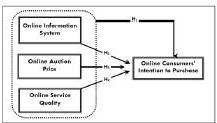
Fig. 1: Research Model of the Relationship of Online Information System, Online Auction Price, Online Service Quality, and Consumers’ Intention to Purchase
Research Methodology
This study has conducted a questionnaire-based survey because the target subjects are individual participants in an online marketplace. The target online auction marketplace is Sanook.com, the most famous and popular online auction marketplace in Thailand. The population of online consumer is about 50,000 users in 2010 (Sanook.com). Therefore, stratified random sampling is done collect the data from samples, which represent all the populations’ characteristics. Sample size was calculated by using Yamane formula (Yamane, 1967) with the significant level 95 percent. We got sample size 397 samples for the convenience sampling.
The questionnaire consists of three parts, i.e. part 1: questions about demographic data, part 2: asking about online information system, price, and service quality toward consumers’ intention to purchase, and part 3: asking about the influence of consumers’ intention to buy. All questions required respondents to rate items based on a 5-point liker response format, from 1 to 5 (from strongly disagree split infinitive. The measurement of online information quality comprised of nine items derived from the work of Hasan and Abuelbrub (2009), which employs four sub-dimensions of online information quality, i.e. content quality, design quality, organization quality, and user-friendly quality. To measure online auction price, we used six items of two prior studies, i.e. three items were from the work of Ariely, and Simonson (2003), and three items were from the work of Halstead and Becherer (2003). Meanwhile, to measure e-service quality, we adopted the work of Wolfinbarger and Gilly (2003), Lee and Lin (2005), Parasuraman et al. (2005), and Bauer et al. (2006). Finally, to measure the degree of e-service quality, we adopted the work of Wolfinbarger and Gilly (2003), Lee and Lin (2005), Parasuraman et al. (2005), and Bauer et al. (2006).).
The demographic characteristics of the sample reveal some important information, such as, people at age 20-30 are active in using internet, student and private sector employee are the dominant profession, and bachelor degree holders is more involved in internet activities, as shown in Table 1.
Table 1: Demographic Descriptive
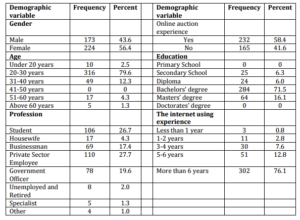
As shown in Table 2, the overall Cronbach’s alpha reliability coefficient for 26 items was 0.871. It means that those items used in the questionnaire were highly satisfactory and acceptable, because all Cronbach’s alphas relatively are closed to 1.0.
Table 2: Descriptive Statistics
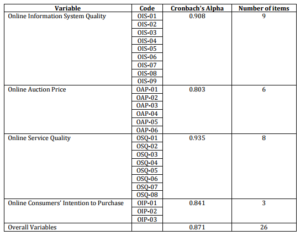
To test the hypotheses, we employed multivariate regression where online consumers’ intention to purchase was the dependent variable and online information system quality, price, and e-service quality were the independent variables.
Findings and Discussion
Descriptive Statistics and Classical Assumptions Test
In this section, descriptive statistics and correlation analysis are used to test the bivariate relations by comparing the correlation coefficient for each variable. The results of descriptive statistics are reported in Table 3.
Table 3: Descriptive Statistics

To test hypothesis 1, we used Pearson Correlation Analysis and the results are shown in Table 4.
Table 4: Inter Correlation Analysis
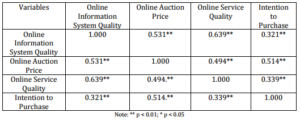
Based on information in Table 4, the correlation coefficient of online information quality, online auction price, online service quality toward online consumers’ intentions to purchase are 0.321, 0.514, and 0.339, which mean there are significantly and positively correlation between online information system, online auction price, and online consumers’ intention to purchase. Therefore, the hypothesis 1 is accepted. To test hypothesis 2, 3, and 4, we employed partial correlation analysis to each hypothesis as follows.
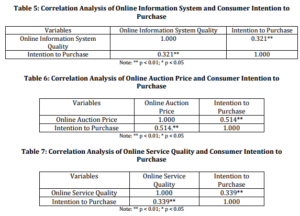
Based on information in Table 5, 6, and 7, the hypothesis 2, 3, and 4 are accepted. All independent variables have a significant and positive relationship toward consumers’ intention to purchase.
To test the hypothesis 5, we employed multiple regression analysis to investigate the relationship between independent variables and dependent variables by running stepwise selection method to identify co-variables for inclusion in a multiple-regression model. This step will choose the least significant variable to be dropped (Zikmund et al., 2010).
Table 8: Multiple Regression Analysis by Stepwise Method (Model Summary)

In our study, model 1 refers to the first stage of the hierarchy when online auction price is used as a predictor, meanwhile, model 2 refers to the final model (online auction price and e-service quality are included into the model).). When we included online auction price and e-service quality (model 2) into the model, the R square decreased into 27.4% of the variance in online consumers’ intention to purchase. This result has a similar pattern when we employed ANOVA analysis for both models. Table 8 shows that F-ratio for Model 1 is bigger and significant compared to Model 2. It means that the use of online auction price to predict consumers’ intention to purchase for Thai respondent is more valid, and then we include e-service quality together with online auction price.
Table 9 reveals that the beta (β) value for online auction price in Model 1 is 0.514, which is positive and significant to predict consumers’ intention to purchase. This value is bigger than in Model 2, which is only 0.459. It means that in Model 1, online auction price has a more beta value factor in predicting consumers’ intention to purchase (unstandardized coefficient: 0.661). Therefore, we can accept the hypothesis 1 saying that online auction price is the factor that contributes most in influencing the online consumers’ intention to purchase.
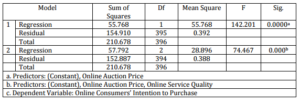
Table 9: Multiple Regression Analysis
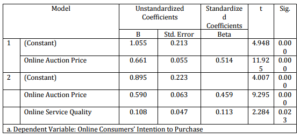
Discussions
The results of our study have verified the prior findings (Zang and Von Dran, 2002; Liang and Lai, 2000; Calisir et al., 2009) that online information system quality is one of the factors influencing in online consumers’ purchasing behavior. It also supports the work of Kwon et al. (2002) that found a positive relationship between website effectiveness and the intention to purchase. Our study has equally important strengthened the study of Calisir et al. (2009) that argue the website-interface, such as web design, has attracted web user to visit and become a regular visitor of the website and convert them into customer.
This study also finds that online auction price and online or e-service quality are positively related to the intention to purchase. It supports previous studies (Ariely and Simonson, 2003; Bauer et al., 2006; Parasuraman et al., 2005; Yen and Lu, 2008) that price is the critical decision-making factor, and seller’s online service quality is the crucial factor to influence a buyer to purchase.
What managerial implications can be derived from this study? Even though price is the main factor among other determinants, it does not mean owner website, internet marketers, online vendors, or seller just pays attention to manage price as the main way to attract customers. It is important to develop and improve the quality of the website and focus to ease of use of their website to be easier, simple, and convenient for its existing costumers or prospective potential customers. The website appearance should be easy to understand, navigate, and be saving time in loading the page. These features will provide a supportive environment for the shopper to be comforted and increase the probability to revisit the website. In the context of pricing strategy, it is recommended to set lower start bid to attract or engage more online bidders or online consumers. Even though the fact is the English auction mode is the most online auction preferred mode today, many online bidders are tending to risk-aversion customers, which are sensitive to the price in bidding.
Lastly, in terms of online service quality, the website owners/internet marketers/ or sellers should ensure that their online auction and shopping marketplace have a legal and safe infrastructure, in order to establish an efficient environment and also facilitate trading activities that are efficient and privacy protected.
Conclusion
The study has supported previous empirical findings in a certain degree. The positive and significant individual effect of online information system quality, online auction price, and e-service quality on online consumers’ intention to purchase has lent a good indication for further research to explore this phenomenon in the context of emerging e-commerce markets. The positive and significant effect of online price on the intention to purchase has provided supporting findings for the online marketers or online sellers in managing better pricing strategy. Finally, the simultaneously effect of quality system, price, and e-service quality on the intention to purchase provides basic findings of those variables that have not been proposed previously in many empirical studies in the context of developing countries’ environment.
Even though our study contributes to knowledge by providing new empirical findings in an emerging market, it suffers some limitations. Firstly, it lacks more sophisticated research method to test simultaneously the relationship of online information system quality, price, and e-service quality. Secondly, our study may have limited generalization to other emerging countries, which our observation was concentrated only in one provide or website. Thirdly, the sampling method probably has biases due to the population of online auction in Thailand is quite large and concentrated in a certain demographic background. These limitations at the same time open great opportunities to expand in further studies.
References
Ariely, D. & Simonson, I. (2003). “Buying, Bidding, Playing, or Competing? Value Assessment and Decision Dynamics in Online Auctions,” Journal of Consumer Psychology Vol.13, 113-123.
Publisher – Google Scholar – British Library Direct
Bajari, P. & Hortacsu, A. (2003). “Economic Insights from Internet Auctions,: Journal of Economic Literature 42, 457-486.
Publisher – Google Scholar – British Library Direct
Barnes, S. & Vidgen, R. (2001). ‘Assessing the Quality of Auction Websites,’ Hawaii. Proceedings International Conference on System Science, 114-127.
Bapna, R., Goes, P. & Gupta, A. (2001). “Insights and Analyses of Online Auctions,” Communications of the ACM44(11), 42—50.
Publisher – Google Scholar – British Library Direct
Bapna, R., Goes, P. & Gupta, A. (2003). “Analysis and Design of Business-to-Consumer Online Auctions,”Management Science 49(1), 85—101.
Publisher – Google Scholar – British Library Direct
Bauer, H. H., Hammerschmidt, M. & Falk, T. (2005). “Measuring the Quality of E-Banking Portals,” International Journal of Bank Marketing, Vol. 23 No. 2, 153-75.
Publisher – Google Scholar
Becherer, R. C. & Halstead, D. (2004). “Characteristics and Internet Marketing Strategies of Online Auction Sellers,”International Journal of Internet Marketing and Advertising Vol. 1 No. 1, 24—37.
Publisher – Google Scholar – British Library Direct
Bland, E. M., Black, G. S. & Lawrimore, K. (2005). “Determinants of Effectiveness and Success for eBay Auctions,” The Coastal Business Journal Vol. 4 Issue 1, 5—15.
Publisher – Google Scholar
Calisir, F., Bayraktaroglu, A. E., Gumussoy, C. A., Topcu, Y. I. & Mutlu, T. (2010). “The Relative Importance of Usability and Functionality Factors for Online Auction and Shopping Web Sites,” Online Information Review Vol. 34 No. 3, 420-439.
Publisher – Google Scholar
Chen, L.- D. & Tan, J. (2004). “Technology Adaption in E-Commerce: Key Determinants of Virtual Store Acceptance,”European Management Journal 12(1), 74-86.
Publisher – Google Scholar
Chuchinprakarn, S. (2005). “Application of the Theory of Reasoned Action to On-Line Shopping,” Knowledge Center E-paper Bangkok University, January — June 2005, 1-7.
Publisher
Cohen, A. (2002). ‘The Perfect Store: Inside eBay,’ Boston: Little Brown and Co.
Google Scholar
D’Souza, C. & Prentice, D. (2002). “Auctioneer Strategy and Pricing: Evidence from an Art Auction,” Market Intelligence and Planning 20(7), 417—427.
Publisher – Google Scholar – British Library Direct
Dodonova, A. & Khoroshilov, Y. (2004). “Anchoring and Transaction Utility: Evidence from On-line Auctions,” Applied Economics Letters 11(5), 307-310.
Publisher – Google Scholar – British Library Direct
Eisingerich, A. B. & Kretschmer, T. (2008). ‘In E-Commerce, More is More,’ Harvard Business Review Vol. 86 (March), 20-21.
Google Scholar
Gefen, D., Karahanna, E. & Straub, D. W. (2002). “Trust and TAM in Online Shopping: An Integrated Model,” MIS Quarterly Vol. 26 No. 2, 51-90.
Publisher
Gregg, D. G. & Scott, J. (2006). “The Role of Reputation Systems in Reducing Online Auction Fraud,” International Journal of Electronic Commerce 7(4), 199—220.
Publisher
Grewal, D., Krishnan, R., Baker, J. & Borin, N. (1998). “The Effect of Store Name, Brand Name and Price Discounts on Consumers’ Evaluations and Purchase Intentions,” Journal of Retailing 74, 331-345.
Publisher – Google Scholar – British Library Direct
Halstead, D. & Becherer, R. C. (2003). “Internet Auction Sellers: Does Size Really Matter?,” Internet Research: Electronic Networking Applications and Policy Vol. 13 No. 3, 183-194.
Publisher – Google Scholar – British Library Direct
Hasan, L. & Abuelrub, E. (2008). “Assessing the Quality of Web Sites,” Journal of Computer Science 7, 11-20.
Publisher – Google Scholar
Hathairath, K. (2009). ‘E-Auction in Thailand’s Rice Business Export,’ Working Paper Thammasart University, 1-8.
Haubl, G. & Popkowski Leszczyc, P. T. L. (2003). ‘Minimum Prices and Product Valuations in Auctions,’ Working Paper Number 03-117, Marketing Science Institute.
Google Scholar
Jarvenpaa, S. L. & Grazioli, S. (1999). ‘Surfing among the Sharks: How to Gain Trust in the Cyberspace,’ Financial Times Supplement, 15 March.
Jarvenpaa, S. L. & Leidner, D. E. (1998). “Communication and Trust in Global Virtual Teams,” Journal of Computer-Mediated Communication 3(4). http://jcmc.indiana.edu/vol3/issue4/jarvenpaa.html (accessed August 24, 2011).
Publisher
Jarvenpaa, S. L. & Todd, P. A. (1996). Consumer Reactions to Electronic Shopping on World Wide Web. International Journal of Electronic Commercial 1(2), pp. 59-88.
Jarvenpaa, S. L., Tractinsky, N. & Vitale, M. (2000). “Consumer Trust in an Internet Store,” Information Technology and Management 1, 44-57.
Publisher – Google Scholar – British Library Direct
Kamins, M. A., Dreze, X. & Folkes, V. S. (2004). “Effects of Seller-Supplied Prices on Buyers’ Product Evaluations: Reference Prices in an Internet Auction Context,” Journal of Consumer Research 30(4), 622-628.
Publisher – Google Scholar – British Library Direct
Keller, K. L. (1993). “Conceptualizing, Measuring, and Managing Customer-Based Brand Equity,” Journal of Marketing 57, 1-22.
Publisher – Google Scholar – British Library Direct
Klemperer, P. (2002). “What Really Matters in Auction Design,” Journal of Economic Perspectives 16(1), 169—190.
Publisher – Google Scholar – British Library Direct
Kwon, O. B., Kim, C.- R. & Lee, E. J. (2002). “Impact of Website Information Designs on Consumers Ratings of Web-Based Auction Sites,” Behavior and Information Technology 21(6), 387-402.
Publisher – Google Scholar – British Library Direct
Liang T. P. & Lai, H. J. (2000). “Electronic Store Design and Consumer Choice: An Empirical Study,” in Proceeding of the 33rd Hawaii International Conference on System Sci., 1-10.
Publisher – Google Scholar
Loiacono, E. T., Watson, R. T. & Goodhue, D. L. (2002). “WEBQUAL™: A Measure Of Web Site Quality,” in Evans, K. & Scheer, L. (Eds), Marketing Educators’ Conference: Marketing Theory and Applications, Vol. 13, American Marketing Association, New York, NY, 432-7.
Publisher – Google Scholar
Madu, C. N. & Madu, A. A. (2002). “Dimensions of E-quality,” International Journal of Quality & Reliability Management 19(3), 246-259.
Publisher – Google Scholar – British Library Direct
Massad, V. J. & Tucker, J. M. (2000). “Comparing Bidding and Pricing between In-Person and Online Auction,”Journal of Product and Brand Management 9(5), 1061-1088.
Publisher – Google Scholar – British Library Direct
McKnight, D. H., Choudhury, V. & Kacmar, C. (2002). “Developing and Validating Trust Measures for E-Commerce: An Integrative Typology,” Information Systems Research 13(3), 334-359.
Publisher – Google Scholar – British Library Direct
Meyerson, D., Weick, K. E. & Kramer, R. M. (1996). Swift Trust and Temporary Groups, In R. M. Kramer, & T. R. Tyler (Eds.), Trust in Organizations: Frontiers of Theory and Research, 166—195. Thousand Oaks: Sage.
Publisher – Google Scholar
Negash, S., Laily, H. P. & Ali, K. (2009). ‘Quality and Effectiveness in Web-Based Customer Support System,’Information and Management 40(8), 757-768.
Ngai, E. W. T. & Wat, F. K. T. (2002). “A Literature Review and Classification of Electronic Commerce Research,”Information & Management 39(5), 415-429.
Publisher – Google Scholar
Parasuraman, A., Zeithaml, V. A. & Malhotra, A. (2005). “E-S-QUAL: A Multiple-Item Scale for Assessing Electronic Service Quality,” Journal of Service Research Vol. 7 No. 3, 213-33.
Publisher – Google Scholar
Pathak, S. V., Tripathi, A. P. & Agrawal, N. (2009). “Analyzing the Impact of Buyers’ Perception of Product-Quality in Indian Scenario: A Primary Research for Selected Durable, Semi-Durable and Fmcg Products,” DMS Business Review Vol. 1 No. 1, 99-132.
Publisher
Pavlou, P. A. & Fygenson, M. (2006). “Understanding and Prediction Electronic Commerce Adoption: An Extension of the Theory of Planned Behavior,” MIS Quarterly Vol. 30 No. 1, 115-43.
Publisher
Pavlou, P. A. & Gefen, D. (2004). “Building Effective Online Marketplaces with Institution-Based Trust,” Information Systems Research Vol. 15, 37-59.
Publisher – Google Scholar – British Library Direct
Popkowski Leszczyc, P. T. L., Qiu, C. & He, Y. (2007). ‘Empirical Testing of the Reference Price Effect of Buy-now Prices in Internet Auctions,’ Working Paper, University of Alberta.
Rao, A. R. & Monroe, K. B. (1988). “The Moderating Effect of Prior Knowledge on Cue Utilization in Product Evaluations,” Journal of Consumer Research 15 (September), 253-264.
Publisher – Google Scholar
Rao, A. R. & Monroe, K. B. (1989).” The Effect of Price, Brand Name, and Store Name on Buyers Perceptions of Product Quality: An Integrative Review,” Journal of Marketing Research 26 (August), 351-357.
Publisher – Google Scholar
Resnick, P. & Zeckhauser, R. (2002). “Trust among Strangers in Internet Transactions: Empirical Analysis of eBay’s Reputation System,” In M. R. Baye (Ed.) Advances in applied microeconomics: Vol. 11. The economics of the Internet and e-commerce, 127—157). Amsterdam: JAI.
Publisher – Google Scholar
Santos, J. (2003). “E-Service Quality: A Model of Virtual Service Quality Dimensions,” Management Service QualityVol. 13 No. 3, 233-46.
Publisher – Google Scholar – British Library Direct
Suter, T. A. & Hardesty, D. M. (2005). “Maximizing Earnings and Price Fairness Perceptions in Online Consumer-to-Consumer Auctions,” Journal of Retailing 81(4), 307-317.
Publisher – Google Scholar
Swaninathan, V., Withem, E. L. & Rao, B. P. (1999). “Browsers or Buyers in Cyberspace? An Investigating of Factor Influencing Exchange,” Journal of Computer Mediated and Communication 5(2), 122-134.
Publisher – Google Scholar
Thai Government Procurement (2003). Regulation of Procurement. Retrieved 25 August 2011, fromhttp://www.gprocurement.go.th/
Publisher
Thunsakul, K. (2010). “Online Business Never on the Brink of Extinction,” Executive Journal Bangkok University Jan-Mar 2010, 55-60.
Publisher
Turban, E. (1997). “Auction and Bidding on the Internet: An Assessment,” Electronic Market 7(4), 7-11.
Publisher – Google Scholar
Waehrer, K., Harstad, R. M. & Rothkopf, M. H. (1998). “Auction Form Preferences of Risk-Averse Bid Takers,” RAND Journal of Economics 29, 179—192.
Publisher – Google Scholar – British Library Direct
Wareham, J., Zheng, J. Z. & Straub, D. (2005). “Critical Themes in Electronic Commerce Research: A Meta-Analysis,”Journal of Information Technology 20(1), 1-19.
Publisher – Google Scholar
Weinberg, B. D. & Davis, L. (2005). “Exploring the WOW in Online Auction Feedback,” Journal of Business Research58 (11), 1609-1621.
Publisher – Google Scholar
Wolfinbarger, M. & Gilly, M. C. (2003). “eTailQ: Dimensionalizing, Measuring and Predicting Retail Quality,” Journal of Retailing Vol. 79, 183-98.
Publisher – Google Scholar
Wu, W. Y., Lin, B. S. & Cheng, C. F. (2009). “Evaluating Online Auction Strategy: A Theoretical Model and Empirical Exploration,” Journal of Computer Information Systems 49(3), 22-30.
Publisher – Google Scholar
Yen, C.- H. & Lue, H.- P. (2008).”Effects of E-Service Quality on Loyalty Intention: An Empirical Study in Online Auction,” Managing Service Quality Vol. 18 No. 2, 127-146.
Publisher – Google Scholar – British Library Direct
Yoo, B. & Donthu, N. (2001). “Developing a Scale to Measure the Perceived Quality of an Internet Shopping Site (SITEQUAL),” Quarterly Journal of Electronic Commerce Vol. 2 No. 1, 31-46.
Publisher – Google Scholar – British Library Direct
Zeithaml, V. A., Parasuraman, A. & Malhotra, A. (2002). “Service Quality Delivery through Web Sites: A Critical Review of Extant Knowledge,” Journal of the Academy of Marketing Science Vol. 30 No. 4, 362-75.
Publisher – Google Scholar – British Library Direct
Zhang, P. & von Dran, G. (2001). ‘User Expectations and Ranks of Quality Factors in Different Website Domains,’International Journal of Electronic Commerce 6(3), 9-34.











